Another week of Hull photos and comments. You can see the new pictures every day on Hull Photos or better on Facebook, where these comments also appear.
Comments on the images welcomed here or on Facebook.
22nd September 2017
A man walks his dog in front of rubble from demolition. In the background at left is the rear of Stepney Primary School, and to its right the rear of the baths and a rather small and undistinguished chimney which still stands. The larger chimney to the right, also seen in the previous picture may have been a part of the Beverley Rd Baths.
The Cottingham Drain, culverted some years before I took this picture, ran behind the school and baths, close to where this picture was taken.
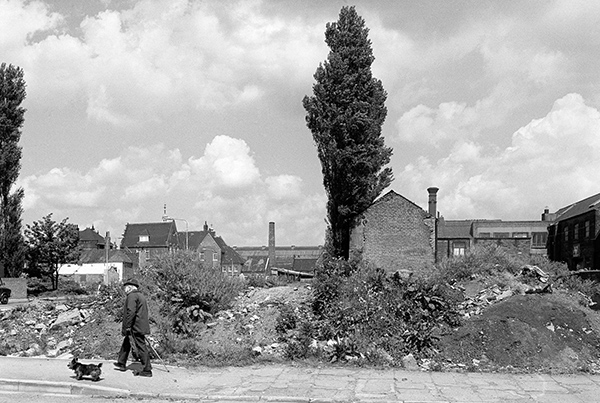
85-5g-25: Man and dog, Epworth St area, 1985 – Beverley Rd
23rd September 2017
Taken from the embankment of the former Hull and Barnsley railway close to Bridlington Avenue this view has a wide sweep of Hull industry in the background, with Reckitt’s chimney and the British Extracting Co silo. But dominating the middle ground are the Grade II listed Northumberland Avenue Almshouses, built in 1884-87 for the Hull Charity Trustees by architects Richard George Smith & Frederick Stead Brodrick of Hull in a domestic Tudor revival style.
According to the Victoria County History at British History Online these new almshouses replaced nine existing ‘Municipal Hospitals’, Crowle’s, Ellis’s, Gee’s, Gregg’s, Harrison’s and Fox’s, Lister’s, Watson’s, and Weaver’s Hospitals. The new almshouses cost £15,000 and took in 114 inmates from the old hospitals.
Northumberland Court is still run by Hull United Charities and is a category 2 sheltered housing scheme for persons over the age of 55, and is now 58 modernised self-contained flats. The site also includes Richardson Court which also provides sheltered housing.
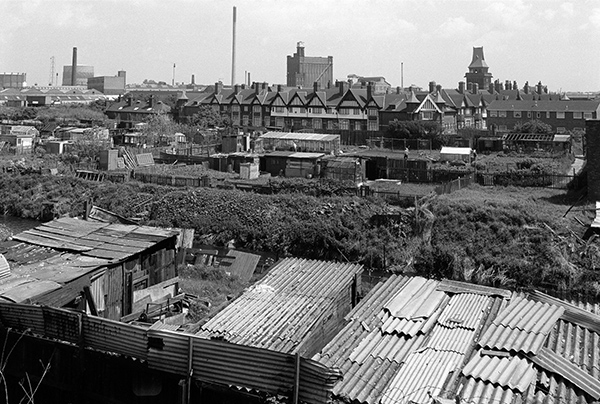
85-5g-42: Beverley & Barmston Drain, allotments & Northumberland Court, 1985 – Beverley Rd
24th September 2017
From the same viewpoint as the previous image, a telephoto view of the Grade II listed Northumberland Avenue Almshouses shows more clearly the work of Smith & Brodrick. In Yorkshire: York and the East Riding, Nikolaus Pevsner and David Neave state they “had the largest (architectural) practice in East Yorkshire, but their work is of mixed quality, with the more distinctive buildings from the late 1870s suggesting the influence of Norman Shaw and the Queen Anne style.” The building is certainly impressive – if not to everyone’s taste – and despite its large overall size gives the feeling of domesticity, essentially a long terrace of smaller houses, with the added accent of the clock tower.
Two of Hull’s other listed buildings appear behind it, the British Extracting Co Ltd silo with its water tower with a puzzling logo, and just visible right of centre close to a metal chimney, the control room on top of the Wilmington Railway Swing Bridge.
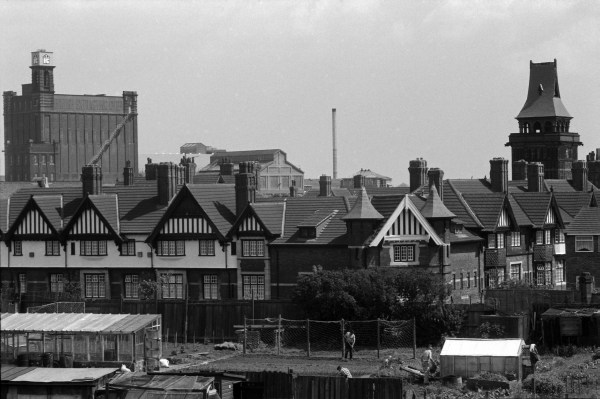
85-5g-43: Northumberland Avenue Almshouses from the Hull & Barnsley embankment, 1985 – Beverley Rd
25th September 2017
Robert Paul (1806-1864) founded Pauls Malt Ltd in Ipswich around 1842, after the family business with a small brewery and its 15 public houses, a saddlery and an ironmongers had been sold up. The business which at his death had 11 small maltings and six barges, passed to a trust until his two sons, Robert Stocker (1845-1909) and William Francis (1850-1928) reached the age of 24. Under them and with financial help from Robert’s father-in-law the business prospered and diversified into animal feedstuffs flaked maize and shipping, and in 1893 became a private limited company, R & W Paul Ltd. The company purchased a number of other companies in London, Lincolnshire, Norfolk and in 1918, the Hull Malt Company, converting their works to mill animal feeds. Expansion continued with other company purchases and in 1960 the company became public and acquisitions and mergers continued, with the company investing in Belgium, France and Germany.
But the 1979 recession hit the company hard, and shortly before I took this picture the company was acquired by Harrisons and Crosfield, though George Paul, the great great grandson of the founder remained as chief executive Two year later Paul’s took over their major competitor Associated British Maltsters to become the largest maltsters in Europe, but in 1998 Harrisons and Crosfield sold Paul’s to the Irish-based Greencore.
Maizecor Foods Limited appear to have taken over the business and their registered office moved to this address around 1998. Since then the business has had a number of crises, but has managed to continue.
Scott St Bridge was unfortunately closed to traffic in 1994 and has been permanently raised since then, and looks as if it is being deliberately allowed to deteriorate by Hull Council. The council tried unsuccessfully to get permission to demolish this listed building a few years ago but were refused permission by the Government in 2012. Many in Hull would like to see it kept as a part of the city’s heritage and reopened if only as a useful cycle and pedestrian route.
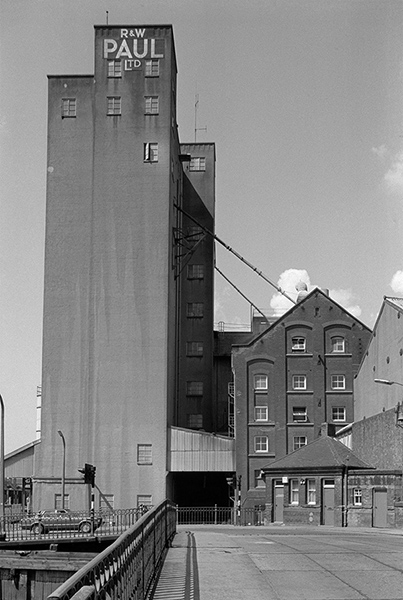
85-5g-51: R & W Paul silo from Scott St Bridge, 1985 – River Hull
26th September 2017
The two buildings closest to the camera on opposite banks of the river are still standing but the other riverside buildings visible here on Wincolmlee have been demolished and the ground stands empty and unused.
The vessel proceeding upriver is the small RIX tanker Beldale H, loaded and fairly deep in the water.
Moored at right is the Krystle, a small 380 tons gross general cargo ship built in Appingedam in the Nethrlands in 1961 which over her lifetime had a succession of names, Visserbank, Aegean Eind, Rene S, and Trio before becoming Krystle from 1985-8 and ending her life as Michelle. She was last recorded at San Lorenzo in 1995 sailing under a Honduran flag and has almost certainly since been lost or broken up.
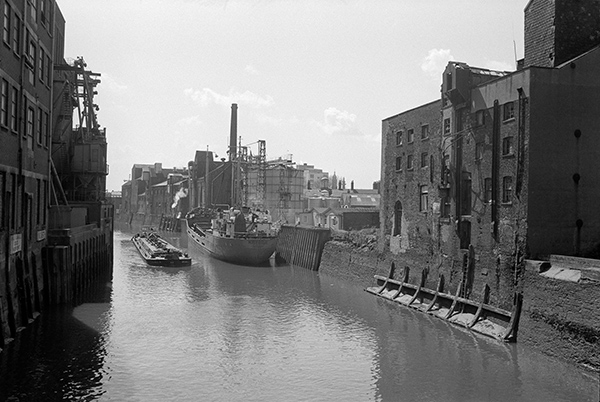
85-5g-52: River Hull, downstream from Scott St Bridge, 1985 – River Hull
27th September 2017
The name on the bridge across Wincolmlee has changed to Maizecor, the windows on the ground floor of the silo have disappeared, though you can still see the ghosts of their presence. There is now a metal security shutter in place of the gated entrance, and the top right window of the brick building has been bricked up but the differences are relatively minor. The lamp post in the foreground is still there, though the actual light fitting has disappeared.
The big difference is out of picture to the right, where the bascules of Scott St Bridge are now locked near vertical, the bridge closed to the road since 1994. The now redundant 10 tonnes weight limit sign has gone, though there are now newer equally unneeded 6’6″ width restriction signs on both sides of the vestigial street leading up to the up-ended roadway, as well as some sturdy black and white striped posts to enforce that limit.
Further down Wincolmlee the public footpath sign as gone, though the path is still there, and three trees above the former Cottingham Drain it runs beside restrict the view of W & J Oliver Engineers and Smiths (now ‘stead engineering’) and the premises beyond.
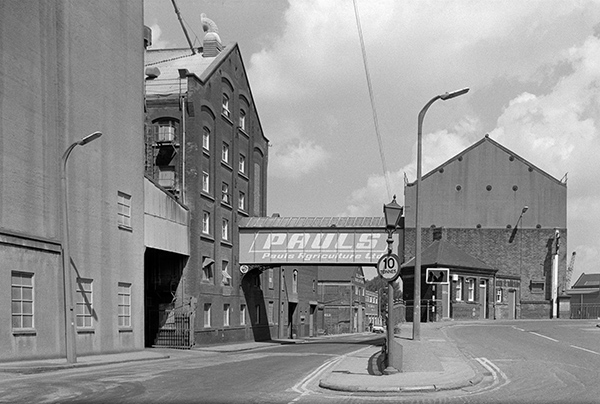
85-5g-53: Wincolmlee and Scott St bridge approach, 1985 – River Hull
28th September 2017
This rather empty yard is now occupied by John Brocklesby Metal Management at 92-96 Lime St, and both the brick building at right and that in the background at the centre of the picture are still there. Whether any of the building at left is hidden beneath metal cladding on the large metal shed now on the site is hard to tell, though I think not.
The low wall at the end of the yard is the river wall, and the more distant building is on the other side of the River Hull, the more northerly of two large mills at around 196 Wincolmlee, the Grade II listed High Flags Mill.
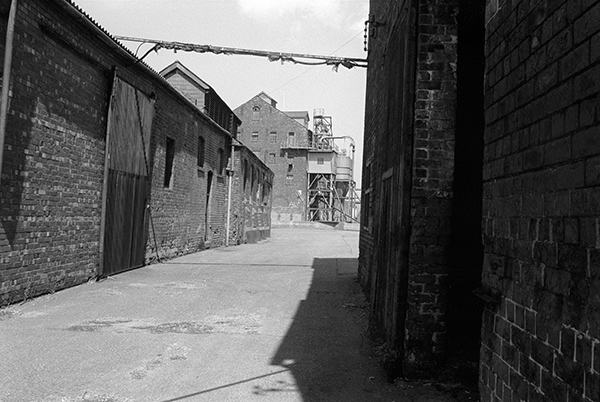
85-5g-62: High Flags Mill from Lime St, 1985 – River Hull
29th September 2017
Taken from Scott St Bridge, this shows one of the older industrial buildings along the River Hull, Paul’s riverbank Granary building, linked on its other side across Wincolmlee to the rest of the mill complex. At the extreme left you can see the bell used to warn of the bridge lifting, in front of the windows of the Paul’s building across Wincolmlee.
The local listing describes it as “Characteristic and increasingly rare historic riverside building. Important for illustrating the history of Hull’s development as a port in the 19th century. Extant in 1853 and pictured in a F. S. Smith drawing of 1888. Distinctive early 20th century iron covered overhead footbridge linking the former granary to the mill across the road has attractive decorative roundels in the wrought iron brackets at either side.”
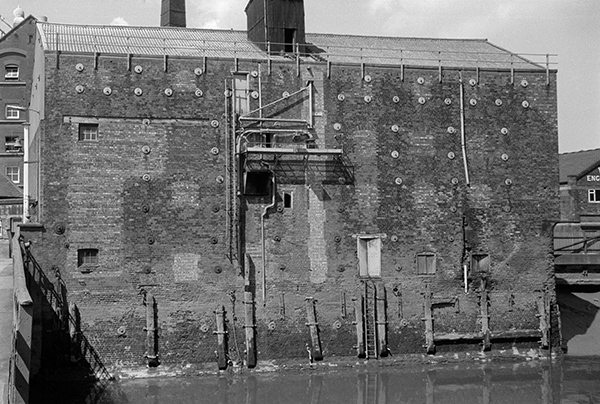
85-5g-66: Granary, R & W Paul, Scott St/River Hull, 1985 – River Hull
You can see the new pictures added each day at Hull Photos, and I post them with the short comments above on Facebook.
Comments and corrections to captions are welcome here or on Facebook.
______________________________________________________
There are no adverts on this site and it receives no sponsorship, and I like to keep it that way. But it does take a considerable amount of my time and thought, and if you enjoy reading it, a small donation – perhaps the cost of a beer – would be appreciated.
My London Diary : Buildings of London : River Lea/Lee Valley : London’s Industrial Heritage
All photographs on this and my other sites, unless otherwise stated, are taken by and copyright of Peter Marshall, and are available for reproduction or can be bought as prints.